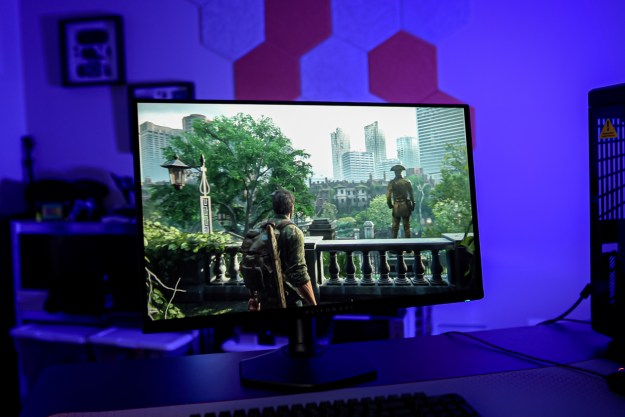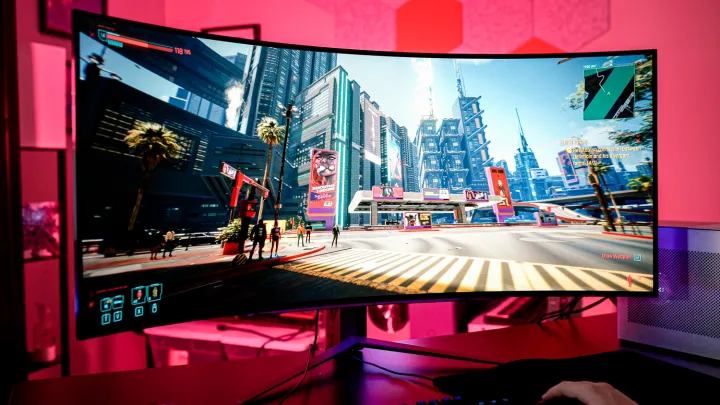
The two major innovations in gaming displays over the past few years have been OLED and mini-LED. These two types of displays have transformed the rather dire state of HDR for PC gamers, and now, you can find OLED and mini-LED options across gaming monitors, laptops, and TVs.
From my perspective, though, there’s really only one choice for the best gaming experience.
Although both mini-LED and OLED improve the gaming experience with excellent HDR, OLED still holds a massive advantage over mini-LED, and that advantage is on full display when it comes to playing games.
The difference
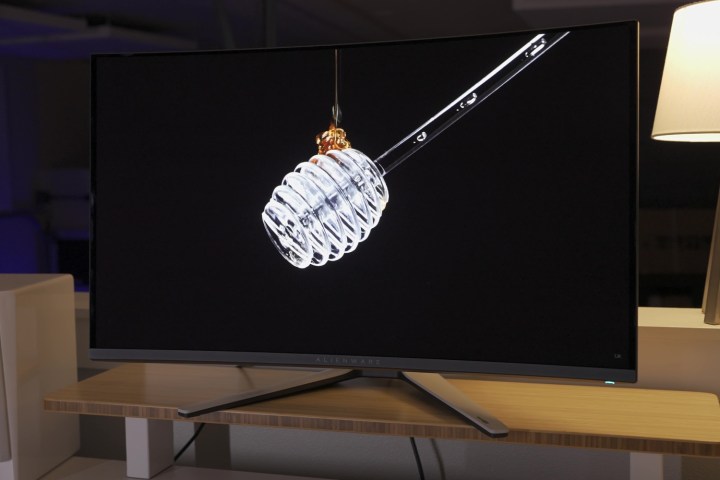
Let’s make sure we’re all on the same page here. OLED stands for Organic Light-Emitting Diode, and LED stands for just Light-Emitting Diode. Sounds similar, but they couldn’t be more different. LEDs just produce light; they don’t produce the color or image you see. Instead, LEDs light up an LCD, which produces the image you see. LED is a lighting technology, not inherently a display technology.
OLED provides both the light and image. There’s no backlight — instead, each of the organic compounds creates its own light. Display makers handle producing the colors in different ways, and it’s not worth getting into here. The important thing to know is that OLED is handling the light and the color, while LED is just handling the light.
That might clue you in on what mini-LED is doing. With an LCD display, the LED backlight is split into a number of zones. Maybe you have one big light that illuminates the full display, or you have eight strips of LEDs that split the display into a few zones. The big advantage of mini-LED, as the name implies, is that the physical lights are smaller. Instead of a few dozen LEDs, you can cram in hundreds or even thousands in the same space. You can see mini-LED at play in monitors like the Cooler Master Tempest G27Q.
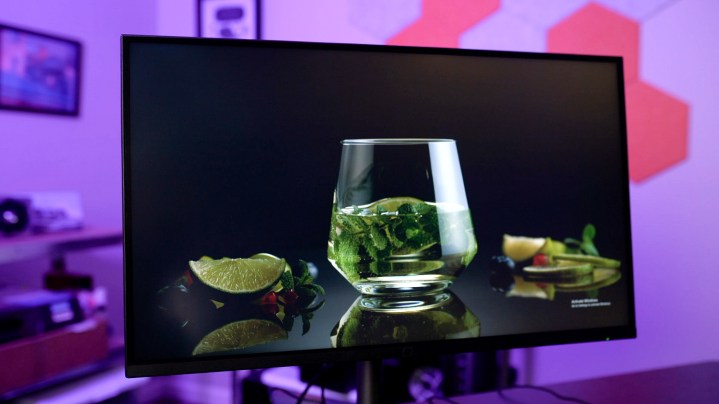
With more individual LEDs, the display can locally control the light. Darker areas can have less light, while brighter areas can have more. With fewer zones, or a universal LED backlight, you give up contrast. The backlight must be at a certain brightness regardless of the content on-screen.
Mini-LED is trying to emulate what OLED does so well. Since OLED doesn’t need a backlight, there are no zones. Each pixel emits its own light, so it can get as bright or dark as needed, even turning off completely. It’s the more advanced technology, but it’s surprisingly simpler than mini-LED.
The zone problem

It’s important to understand how mini-LED and OLED differ on a technical level because it makes the experience of using them much easier to understand. The big problem facing mini-LED versus OLED is something called “bloom.”
With mini-LED, you’ll always have more pixels than you will LEDs. Let’s use the Asus ROG Zephyrus M16 as an example. This laptop has a mini-LED display with a resolution of 2560 x 1600, and it has 1,024 dimming zones. Run the numbers, and you can quickly discover that each zone covers about 4,000 pixels.
Bloom happens when something doesn’t fit neatly in the bounds of those dimming zones. For the sake of illustration, let’s say you have an element that’s 2,000 total pixels. The zone must still light up the full 4,000 pixels, creating a halo around the element. It’s particularly noticeable when you have something white (like your cursor) on a black background. With all of the dimming zones turned off except the one where your cursor is, you can see the effect of bloom in action.
In games, this isn’t always a problem. With a detailed game world and a massive array of zones, it’s easy to overcome the effects of bloom on the mini-LED display. It still pops up, though. How many times have you seen white text on a black background in a game? How many times do you hit loading screens with a black background? What about games like Minit that are entirely designed around white assets on a black background?
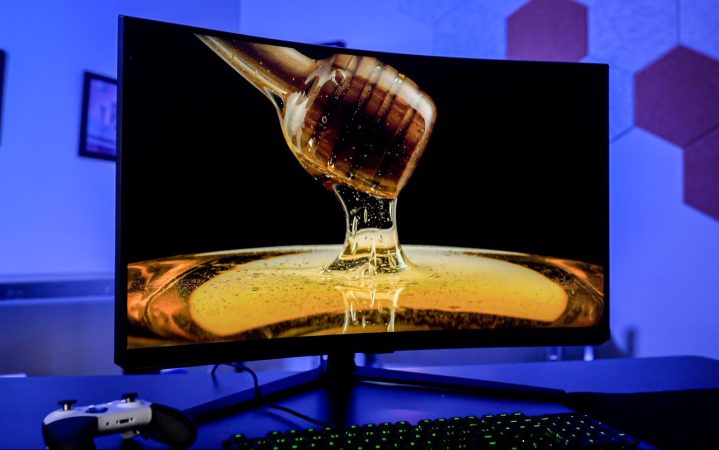
Bloom isn’t a persistent problem on mini-LED monitors, but it can really rip apart the gaming experience when it pops up. OLED doesn’t have that problem.
You don’t have zones with OLED. Each pixel emits its own light, so the pixels that are lit up are the exact ones you need. On top of getting around bloom, OLED can handle brightness differences much more granularly. In those highly detailed scenes, each pixel can handle its own light, giving you a deeper level of contrast across the scene.
I don’t want to talk up that experience too much, though. Both mini-LED and OLED deliver exceptional HDR, even if OLED does HDR a bit better. There’s another compelling reason to use OLED for gaming.
The response time

OLED has insane response times. You’ve probably heard that before, but it’s worth examining it on a technical level. Response time is how long it takes a pixel to transition from one color to the next. It’s measured in a static way — usually transitioning from one gray to another (gray-to-gray response time) — but it’s important to remember that response time is constantly moving.
Lower response times don’t mean the monitor is faster, at least to your eyes. It means the monitor is clearer. If a pixel can complete the transitions from one color to the next faster, you get fewer pixels in fewer frames that are still transitioning, leading to less smearing. There are other factors that impact motion blur, frame persistence being chief among them, but lower response times are still better if you have content moving quickly across your screen.
Mini-LED makes a trade-off between the effectiveness of its dimming zones and the input lag.
OLED response times are almost instant. That’s because each pixel is handling its own light and color. The moment it receives an electrical current, you get the correct brightness and color you need. Mini-LED displays don’t work like that. The LED backlight can illuminate almost instantly, but it takes some time for the LCD layer to react and produce the final image you see. When looking at just pixel response time between OLED and mini-LED, it’s quite literally night and day.
Response time is just one factor when looking at overall input lag, but it exposes another issue with mini-LED that OLED doesn’t suffer from. Because the individual zones create the contrast across your screen, mini-LED usually needs to make a trade-off between the effectiveness of its dimming zones and the input lag.
This comes down to the individual display. Some mini-LED backlights are faster and more aggressive, while others are slower. A lot of mini-LED displays can handle the additional lag incurred by local dimming well enough that you won’t even notice it. Regardless, it’s a factor that OLED doesn’t need to contend with.
The reality

One big factor I haven’t touched on here is price. Mini-LED displays are usually cheaper than OLED displays. For instance, the is about $550, while the LG UltraGear OLED 27 is close to $700 (though, with a faster refresh rate). For a more apples-to-apples comparison, the mini-LED Samsung Odyssey Neo G8 is about $1,000 at the time of writing, while the Alienware 32 QD-OLED is $1,200.
The situation was much worse about a year ago, with OLEDs coming in sometimes close to twice the price. Now, the gap is much smaller, even if OLED is more expensive.
Saving up the extra cash for OLED will get you a better gaming experience, not only from a contrast and HDR perspective but also from a response time perspective. At this point, the prices are close enough that it’s worth justifying spending a bit more on an OLED display if you can find one. We’re seeing more OLED displays in gaming laptops, too, such as the 2024 Asus ROG Zephyrus G14.
If you can only afford a mini-LED display, however, don’t feel like you’re getting the short end of the stick. Compared to monitors we saw just a few years ago, such as the Sony InZone M9, mini-LED is a massive leap forward. OLED may be better for gaming, but mini-LED is still leagues ahead of monitors with global dimming or a few edge-lit dimming zones.
Editors' Recommendations
- The world’s first 8K mini-LED monitor has arrived
- 4 gaming monitors you should buy instead of the Alienware 34 QD-OLED
- Gigabyte just upped its OLED monitor game
- This smartphone company made a shockingly small watercooled gaming PC
- I tested 3 years of mini-LED gaming laptops, and I was shocked by the results





